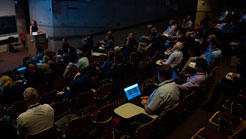4th DATEX II User Forum: Dublin 2016

During the 13th and 14th of September the 4th DATEX II User Forum was held in the Trinity College conference Centre in Dublin, Ireland, where about 80 DATEX stakeholders attended several sessions throughout the User Forum.
Apart from the experienced and more technical users, ‘new’ users were explicitly invited at a management level to join this User Forum. The Forum discussed the pros and cons of DATEX II, how to make best use of DATEX II, how to fulfil the obligations of the ITS Directive by using DATEX II. There was ample time to share this knowledge in direct conversation during the Forum and especially at the evening event that was arranged around the famous Trinity College. And for the ones that are really into the practical side of things, there was the opportunity to participate in a hands-on workshop on DATEX II profiles and extensions.
DAY 1 – Tuesday September 13th, 2016
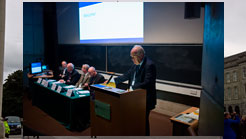
Day 1 started off with the Opening Plenary Session, with a welcome by the Irish host Vinny Cahill, dean of the Faculty of Engineering, Mathematics and Science. Mr. Cahill gave an inspiring speech interlinking the DATEX II User Forum with the research topics and projects dealt with at Trinity College. The User Forum was then opened by Henk Jansma, chair of the DATEX II Steering Group. Mr. Jansma among other aspects introduced the four new DATEX II topics that the programme focusses on: the delegated acts, urban transport, the Stakeholder Advisory Board and Open Data.
The Opening Plenary Session ended with four key note speeches. The key note speeches were done by Dominic Mullaney (Irish Department of Transport, Toursim and Sport), Pat Maher (CEDR), Pedro Barradas (European Commission) and Hermann Meyer (CEO of ERTICO). Dominic Mullaney highlighted the importance to start simple with ITS implementations and showed us how this strategy has worked in Ireland, slowly but steadily implementing several ITS services throughout the country. Pat Maher discussed his support for DATEX II, as he finds it is important for national road administrations as well as for transnational cooperation. Pedro Barradas added that DATEXII is important to achieve the goals of the delegated regulations. Most speakers also mentioned the importance of the urban dimension and how DATEX can play a role in this field. Hermann Meyer ended the Opening Plenary Session with an overview of current trends, policy challenges and technological developments and the role DATEX II can play to cope with these.
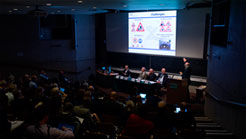

After lunch, day 1 continued with the first plenary session which started off with a series of statements to which the audience was asked to react. These statements provided new insight into several topics related to DATEXII as well as entertainment on subjects like for example the ease with which automated driving will be introduced in different European countries. Next to the statements, this first plenary session allowed several companies to present themselves and their relation to DATEX II. This proved to be a very interactive session, where company representatives and potential clients like road authorities/operators had several interesting discussions throughout the session.
During this session Josef Kaltwasser stressed the need to strengthen the role of standardisation. Maggie O’Donnel (Dublin City) stated the city is increasingly using standards, but that legacy systems make the implementation of such standards more difficult. Johanna Tzanidaki (TomTom and TM2.0) explained how TomTom is a happy user of DATEXII and that TM2.0 I working on interactive TMPs. They are trying to identify if extensions are needed to DATEX in this regard. As has been agreed in September, DATEXII will be cooperating with TM2.0 in this field. Finally, the development and use of standards was underlined by the audience.

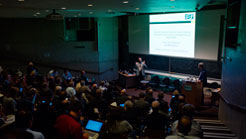
The day ended with the second plenary session which focused on the NRA’s approach to the EU Delegated Acts. This session aimed to show how DATEX II supports the Delegated Acts and in the end the road user. Seven presentations were held by several stakeholders. Ronald Jorna (EU ITS Platform) set the scene for this plenary session. Then Kjersti Leiren Boag (Norwegian Public Roads Administration) discussed the national deployment of DATEX II in Norway. Jonas Jäderberg (Viati) discussed the EU delegated act deployments in Sweden. Then David König (AustriaTech) described DATEX II profiling and testing in the context of the EC delegated regulation requirements. Roland Ziegler (ave-web) then discussed DATEX II Truck Parking in Germany after which Ed Ooms (National Data Warehouse for Traffic Information) then continued to discuss SPA in the Netherlands. Finally, Bard de Vries (Rijkswaterstaat) ended the second plenary session with a presentation on SRTI implementation in the Netherlands.
It could be concluded that there is a lot happening with respect to National Access Points, but more importantly there is still a lot to be done. Only a few countries so far have established National Access Points. It shows that the user support of the Delegated Acts with respect to DATEX, which is included in our new work programme, is on the right track. The second plenary session was a very lively, interactive discussion, showing that the topic is highly relevant.
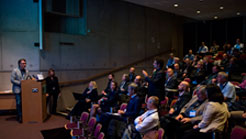

During the evening a social event was organised which started off with a very interesting speech by Joseph O’Gorman on the history of the beautiful Trinity College Dining Hall in which the User Forum attendees enjoyed their dinner.
DAY 2 – Wednesday September 14th, 2016
During the morning of the second day of the User Forum, attendees could choose to either attend a technical session which discussed DATEX II in relation to traffic management, or a hands on session which included a comprehensive tour through the DATEX II data model. During the afternoon attendees could opt to either attend a technical session on the implementation of DATEX II in new domains or to attend a hands on session on DATEX II profiles and extensions.
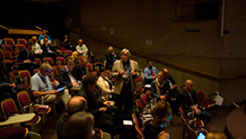
The first technical session dealt with Traffic Management and cooperation between various road operators and cooperation between road operators and information service providers. There are not only organisational problems in the cooperation between actors but also technical issues. In addition, there is a challenge for private information service providers to follow route instructions from TMPs. This should lead to a win-win for road operators and service providers.
It was also discussed that an extension to DATEX II has been created for collaborating ITS services/TMP. In the CHARM project the system will present several options to the operator, including predicted effects. The National Data Warehouse for Traffic Information in the Netherlands developed a system to keep track of roadworks across all road authorities ‘to avoid diversion routes within diversion routes’.
